The Swiss Alps kept us company on the second stage of Tour du Mont Blanc, where the landscape and trails were as varied as the weather. Here we share our experience on how a typical day looks like on TMB. About practical details, hiking clothes for the mountains, and what you get to eat in the huts.
Written by Mette / Photo by Martin
Translated from Danish
When the alarm clock rings at quarter to seven in the morning, it neither sounds nor feels like a holiday. The body is slightly tender and has during the night transformed into a three-dimensional map of muscles we forgot existed. Especially around the knees. An aching sensation that serves as a reminder of how far away from pancake-flat Denmark we roam.
From home, we trained for the trip by hiking long walks in hilly terrain. We frankly admit that it is optimistic to prepare for mountain hiking in a country where the highest summit is Himmelbjerget, which ironically translates into The Sky Mountain. I guess our ancestors didn’t get much out. After all, calling a hill of just 147 meters a “mountain” sounds like megalomania, right?
Lightly drowsy, we throw the covers aside and draw the curtain in the small double room. Kapow! The view of the grandiose mountains rising into the sky just outside our window is striking. And suddenly it pours with dewy memories from yesterday’s experiences and the intoxicating feeling of walking in the vast landscapes. Better gasoline probably doesn’t exist.
Eager to see what the next stage brings, we quickly get dressed and start packing our bags. Meanwhile, grey rain clouds begin to gather in the blue sky. The weather is smoldering, and ahead lies a small challenge we hadn’t seen coming …

Packing the backpack
As beginners in mountain hiking, we have chosen a so-called comfort edition of the Tour du Mont Blanc (TMB). From home, we bought a package deal through a travel agency that planned a route and arranged for our luggage to be transported from cabin to cabin. That way, we have the freedom to hike on our own, but without having to worry about finding shelter every night or lugging a full pack.
Not that the hike, therefore, is easy. The route consists of mountainous stages that meander over a total of 10.000 meters in altitude and rarely offer flat stretches. God had clearly forgotten the spirit level when he created the Alps. For the most part, the paths either go up or down. Straight out basically does not exist. So, the less weight on your back, the better – if you ask us.
Every morning we have the pleasure of packing two bags. A large bag with all our not-relevant-for-today’s-stage-stuff, which will be taken to the next cabin, and a small rucksack that contains only relevant-for-today’s-stage-stuff. Small things such as a map of the hiking route, sunscreen, sunglasses, drinking water, lunch, snacks, and a camera. In addition, there must be room in the rucksack for a change of clothes.
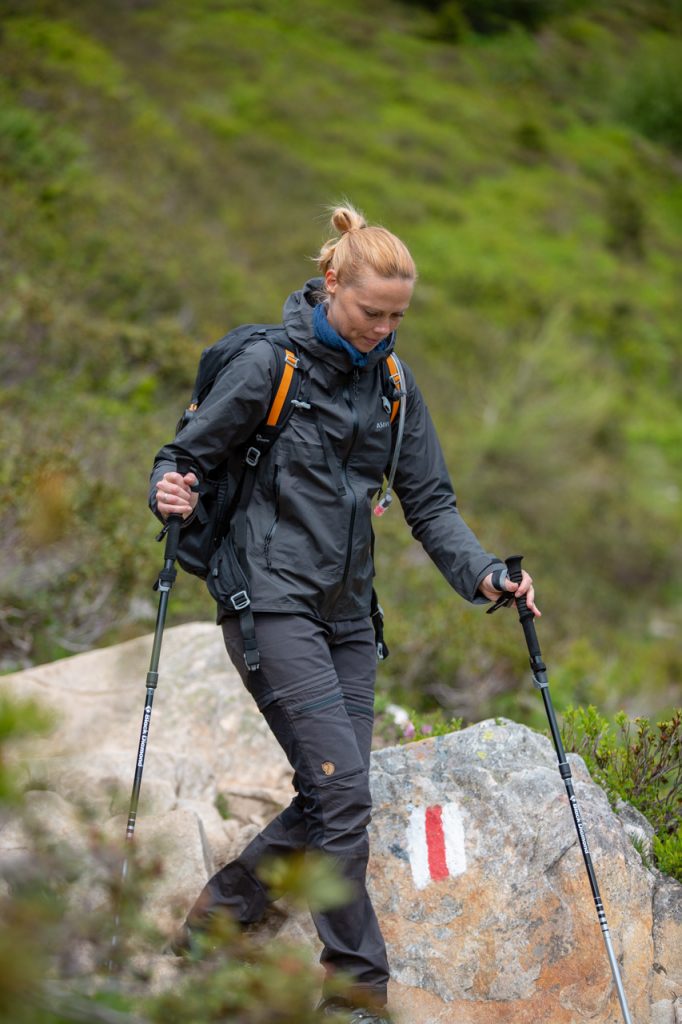
Hiking outfits for mountain weather
The weather in the mountains is a capricious companion. It quickly changes, and the temperatures fluctuate between 10 and 25 degrees. It is cool in the morning when we leave at 8 o’clock and gets warmer during the day. At the same time, it can be a windy pleasure to pass open mountain passes, so it is good to have a warm layer on, even if the trip up often becomes a sweaty affair.
In the morning we, therefore, put on three layers of clothing, as if we had to walk through several seasons in just one day. First, we have a long-sleeved merino wool jersey that functions as both a sweat-transporting and temperature-regulating layer. Next, a hooded sweatshirt in fleece/merino, and in the rucksack, we have a shell jacket that is rain and windproof.
We put on and take off clothes surprisingly often – and in different combinations – during the day. So, the most practical garments quickly become our favorites. For example, it is the first time we have owned long trousers that can be zipped off into shorts – and we love them! In addition, the Buff, a stretchable neck tube, is indispensable. It takes up nothing in the bag and works both as a scarf, headband, and wrist warmer when it’s cool, and a light headgear when the sun is bright.


Breakfast in the Alps
Dressed in hiking uniform, we only need to fill up the energy stores. The dining room is in the living room and is a high-ceilinged room with long tables, wax tablecloths, and large mirrors on white-painted walls. Compared to the tour’s other accommodations, the interior of hotel La Grande Ourse is the least alpine-idyllic. But it is clean, spacious, and functional in the best Swiss manner.
A group of wanderers have already gathered around the tables and sat down in the same places as the small nametags dictated at yesterday’s dinner. Although it feels a bit controlling with the conformal table plan, it undoubtedly makes life easier for everyone. The space is tight in the high season, and the plan ensures that no chair dancing occurs.
We recognize most of the people from yesterday’s dinner and greet a good morning before we attack the buffet. Quite classic for the accommodation along the hiking route, the hotel includes half board, and all cabins operate roughly according to the same setup, which is adapted to hikers’ routines and needs. Breakfast is served in the dining room from seven to eight o’clock, and the buffet typically consists of toast bread, butter, cheese, jam, fruit, cornflakes with milk, and coffee and tea.
After refueling on carbohydrates and caffeine, we pick up our lunch sandwiches, which we ordered the night before, from the kitchen. We then hand over the large luggage at the reception and make sure that the green stickers with the travel agency’s logo are on so that the driver can find them among the stack of bags. We are clearly not the only ones who have opted for the comfort version of the Tour du Mont Blanc.



Far from everyday
An hour after getting up, we eagerly put on our backpacks. A new stage awaits, and the only thing they each have in common is that they take us from the bottom of a grassy valley, over high mountain passes, and down again on the other side. Today, a hike of 18 km and 2.000 meters high mountain passes await. But it will not be the trip upwards that offers today’s challenge. It will be, as always, the trip down.
A little outside the village we find the TMB track and cross the asphalt road onto a narrow path that goes up towards the Col de la Forclaz – the first mountain pass of the day at 1.500 meters. This means that we have to walk almost 300 meters up during the next hour. At a time of day when we normally sit down in front of the computer in each of our office environments.
The contrast between a hiking day and everyday is striking
The path winds steeply up through a dense coniferous forest, and we are repeatedly surprised by how quickly the root-knotted forest path brings us high into the air. Occasionally we can peak through the frame of greenery. It is a fabulous view. With the valley below us and the mountains on the horizon.
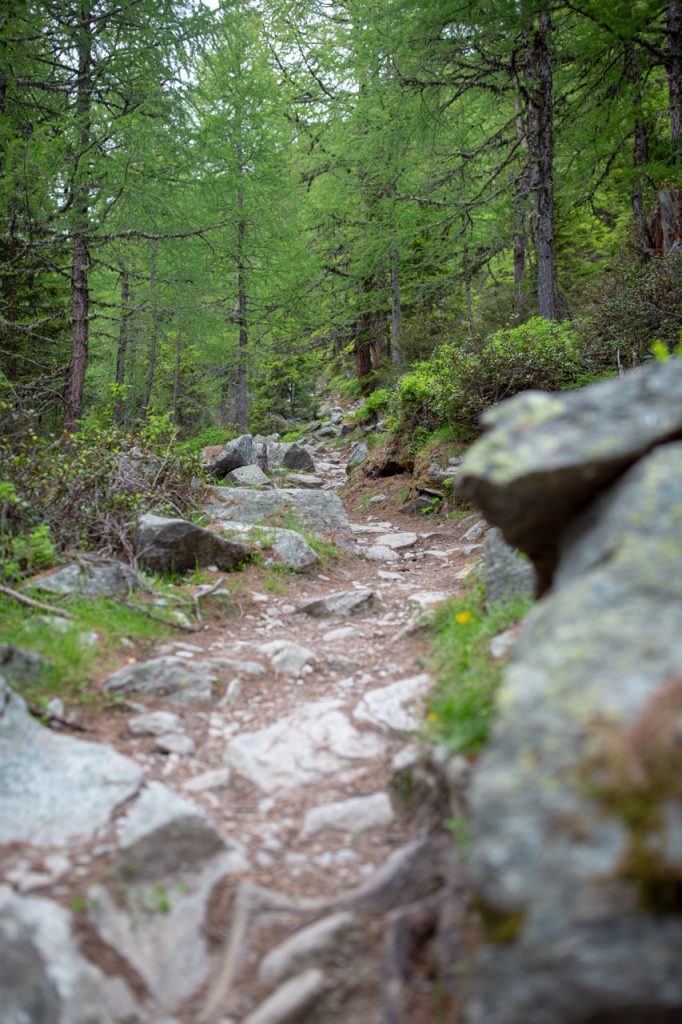
Difficult to calculate
As we approach the pass, the rockier the path becomes and the less dense the forest becomes. Only now can we feel small raindrops falling gently from the sky above us. “I bet it will stop if we put on rain gear”, Martin says. For the past 5-10 minutes we have been discussing whether it is raining enough for us to want to change – and meanwhile, the rain has picked up.
It’s a bet I want Martin to win!
We decide to replace the hoodies with rain jackets and add rain covers to the backpacks. As we muck around, another couple comes striding up the steep path behind us. They have been talking about the exact same thing, says the man with a breathless laugh. Rain or shine, changing clothes is a welcome break.
Further on, the path finally begins to flatten out a bit. We pass through the forest and out to an open plateau with green grass and small lakes. For the first time, we have an unobstructed view of the mountain landscape that surrounds us. The rain clouds hang low in the sky, like grey garlands between the white pointed peaks. It looks bad. But it’s not raining.
1-0 to Martin


Lunch with a view
In the middle of the day, the path makes a bend over a ridge and reveals a view beyond an undulating green mountainside. It gives a great feeling to be able to see so far and at the same time see nothing but mountains. We are 2.049 meters above the water’s surface. Below us, the path winds like a thin thread through the landscape and past an old farm that lies idyllically in the middle of the hill.
This is the Alpage de Bovine, our lunch stop. Here, a small stone hut has been converted into a rustic eatery, where hikers can buy dishes such as omelets, pies, and baguettes. During the week, on each stage, we pass mountain huts like this one. Most often we just buy a cup of coffee or cola and borrow the toilet. We prefer to bring our own lunch, so we can choose where and when we want to eat.
As we hike towards the cabin, the sun burns through the clouds. I look back at Martin, who is laughing at me. I smile so big I look like a split clog (sorry, it’s a strange Danish saying, it means a very big smile). It is remarkable how quickly the weather can change in the mountains. But hooray for that! We eat our sandwiches sitting in the grass. In the finest sunshine and unforgettable panorama. We have managed today’s ascent. From here it is mostly downhill.
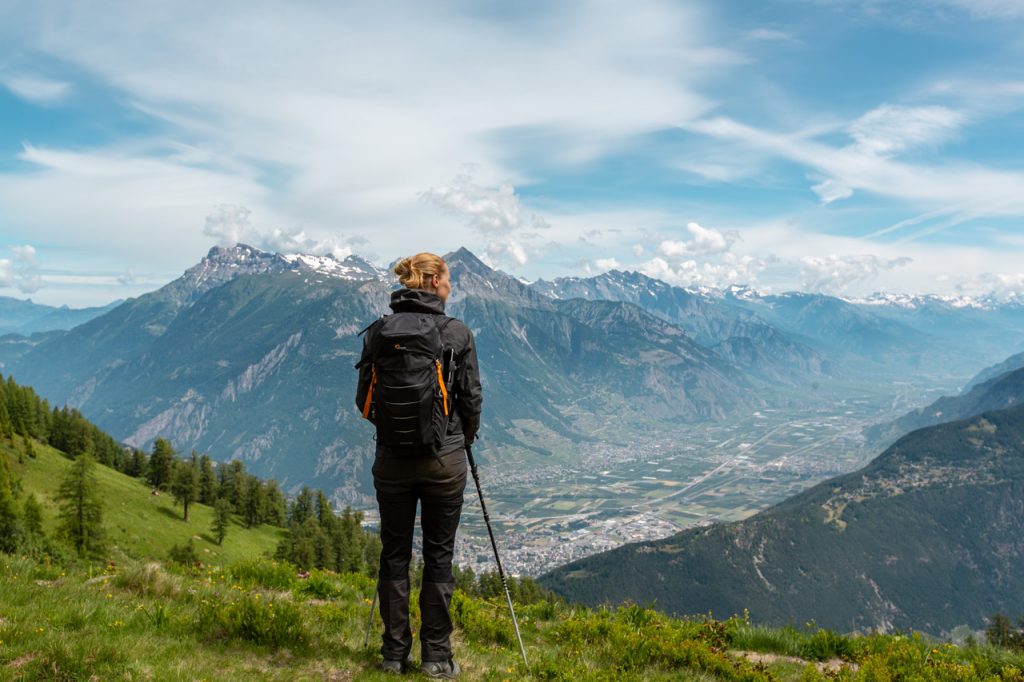
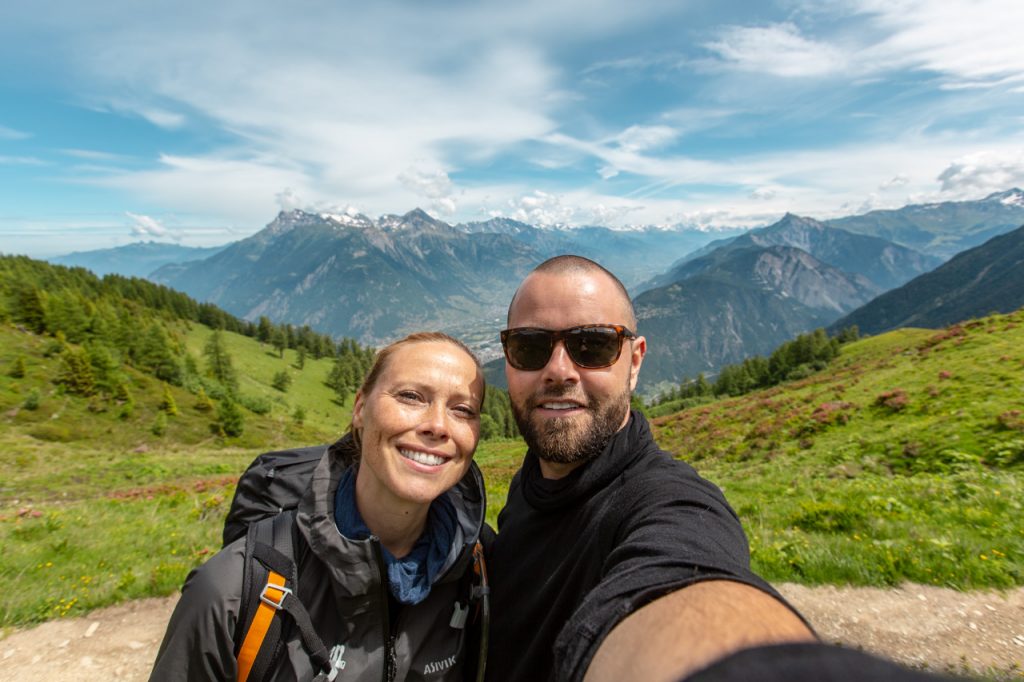
The path that disappeared
We can hear it before we see it. Water cascading down a rocky mountainside. Up until now, our main concern has been whether we could even get around Mont Blanc due to the unusually large amount of snow this winter. We hadn’t really given much thought to the fact that we are in the mountains at the time of year when the snow melts and the water gallops one way: Down.
We have just completed a slightly strenuous descent. A steep forest path with loose stones on top of coarse gravel. Rrrrrtttssschhh … We slid constantly and involuntarily as if the trail were a wave and our boots a surfboard, swept along by the forces of nature. Without walking poles, we would have been on our ass. Often.
Then the path changed to large, angular boulders, challenging balance again. It felt as if we were playing the earth is poisonous as we strode from stone to stone. And now we stand here. The path has led us through a thick bush and out to a clearing, where it disappears under a wide tongue of foaming water. It is difficult to see the bottom below the white water, which continues bluntly beyond a cliff.

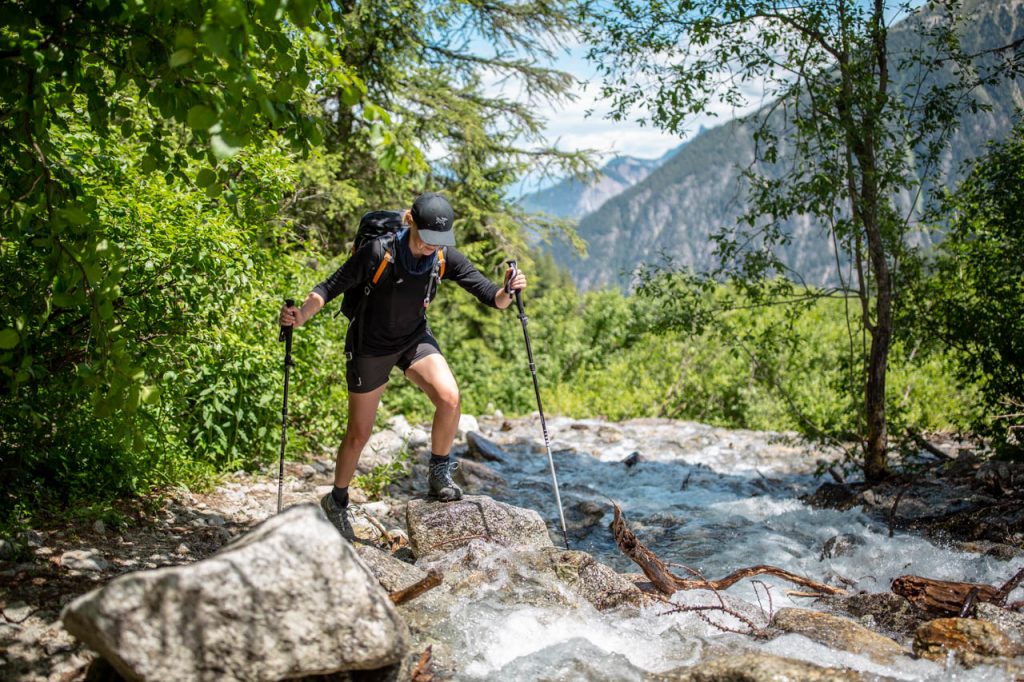
Martin edges along the green in an attempt to find a place we can cross. A little further up, he tentatively steps into the water that swirls around the bottom of his boots. There is a strong current, but it is far from so violent that he cannot resist. Step by step he steps from stone to stone and points where I can follow.
We laugh at each other as we have made it to the other side without any problems. The stream both sounded and looked far worse than it was. We quickly find ourselves back on the path, and from here a far less challenging hike awaits. The last part of the stage goes along gravel roads in conifer forests and wide dirt paths bordered by thigh-high ferns. And over several smaller streams that we wade through, as we have never done anything else.
When you hike at the beginning of the season (mid-June), it brings with it a few minor challenges in the form of both snowdrifts and meltwater. But the view of the varying landscape is worth it. The islands of snow light up in strong contrast to the green and granite-gray colors of the mountains. It looks insanely beautiful!

Dinner in cottage shoes
In the late afternoon, we arrive at Relais d’Arpette, our lodge for the night. Here the receptionist guides us down into the basement, where we find both our luggage and a separate drying room where all hikers must put their boots. A pungent smell of vinegar reveals one of the practical reasons why everyone must park their footwear here.
We jump into the change of shoes we have brought with us, which we have prepared at the top of the large bag and carry our things up to the room. Most mountain huts primarily offer accommodation in dormitories and bunk beds, but our comfort package includes our own double room. The bath and toilet are shared.
We take a quick shower and head to the bar. Nothing beats the taste of a cold beer after seven or eight hours of hiking. The next beer is accompanied by planning for tomorrow. We read the route description, check the weather forecast, and pre-order lunch sandwiches at the kitchen.


Dinner is served at 7 pm and is an Alpine idyllic version of family celebrations in a community hall. Every evening we are served a three-course menu from the local kitchen, often with the option of choosing between two or three different variants of the main course. The starter is typically a hot soup. The main course consists of meat, pasta or polenta, and some vegetables. And the dessert is cake or ice cream with fruit salad.
It’s hard not to be excited about the concept. Eating a three-course meal every day. But where family parties often continue with music and dancing well into the night, the wanderers continue straight to bed. The Sandman is unemployed in the mountains. We fall asleep at the very moment our cheeks touch the pillow. And there is no disturbing waking up before the alarm clock rings.

Useful facts on the second stage
In the hiking guide, we got from the travel agency, various data about today’s stage are listed – i.e., how long it is and how many hours it takes to complete if you walk at an average of 3.5 km/h without breaks.
To give a more realistic picture of the hike, we have added our own data in brackets. We have also added another number, namely how many floors Martin’s GPS watch has registered that we have gone up and down. Although it is a slightly silly scale, it still gives a sense of what it physically requires to hike the stage.
TMB stage 2
• Route: From Trient to Arpette
• Kilometers: 17.5km (25km)
• Altitude difference: 1000 m up / 700 m down
• Altitude meters in total corresponds to the number of floors: 372
• Highest point: 2049 meters
• Time: 5-6 hours (8 hours)
Accommodation
- Trient: La Grande Ourse
- Arpette: Relais d’Arpette

